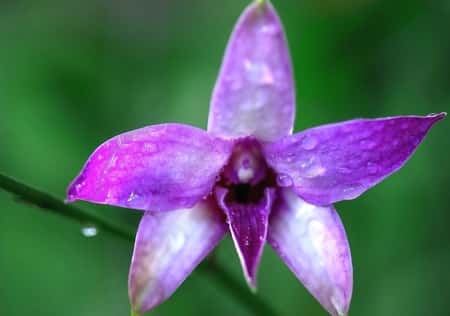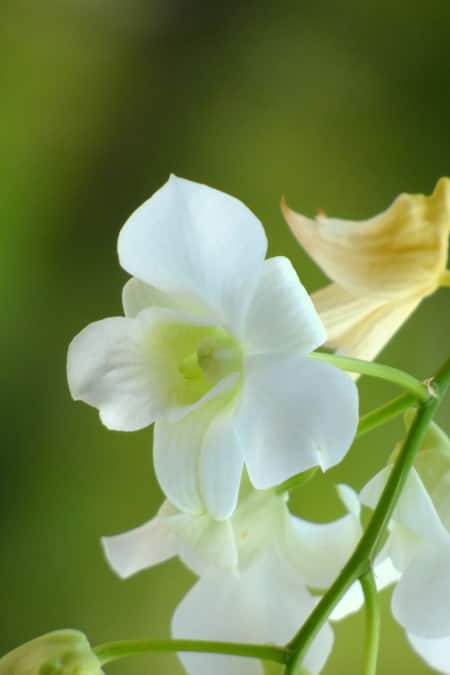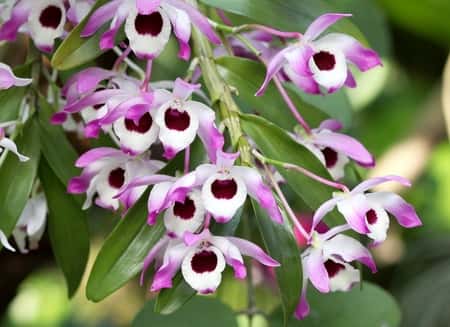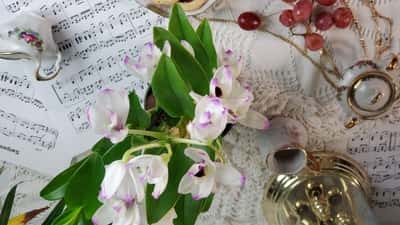You’ve had your orchid for about a year and are anxiously waiting for new blooms to emerge from the spike at any minute. Yet, for some unknown reason, they don’t. Your dendrobium just gets bigger, and bigger, and bigger…but no flowers or blossoms are anywhere to be found. Dendrobiums can be some of the easiest orchids to grow but one of the trickiest to rebloom. To produce gorgeous blooms, there are three requirements that have to be met.
A Dendrobium Nobile will rebloom yearly when a reduction of 20 to 30% in water has occurred, temperatures have dropped to 55° F or 13° C during fall and winter, and when potassium levels are increased. A Dendrobium Phalaenopsis will rebloom up to three times a year when watering is slightly decreased during fall and winter, but all other conditions remain the same.

Dendrobium orchids are one of the biggest groups of orchids with over 1,200 species. Since this orchid genus is so immense, Dendrobiums are divided into five distinct categories or classifications that best group each type of Dendrobium with similar characteristics.
I wrote an in-depth article explaining this classification and the characteristics of each one which you can read in this article. If you’re not sure what type of Dendrobium you have, there would be a good place to start. Then come back to this page to see how to rebloom it.
1) How to Rebloom a Dendrobium Phalaenopsis Orchid
I’ll start with the Phalaenopsis orchid since it is the easiest to rebloom and doesn’t have many requirements. In general, these Dendrobiums are very easy to rebloom. Its growth patterns are similar to the Phalaenopsis, which also hints to the reason for its name.
These orchids, officially classified as Dendrobium Phalaenanthe have a similar flower structure to the moth orchid. They are nick-named Den Phals, but don’t let the name confuse you into thinking they prefer all the growing conditions of the Phalaenopsis orchid.
These are great orchids for starting orchids since they are very tolerant of mistakes and have high ranges of care.
1A) Characteristics of the Den Phals Orchids that Influence Reblooming
The pseudobulbs (or canes) on the Den Phals are immensely large for the size of their pots, but Nobiles can be quite larger. These orchids can grow from 2 to 4 feet or 0.6m to 1.2 meters. Because of their height and thick canes, these orchid’s pseudobulbs are referred to as hard canes. In contrast to the canes, the leaves are pretty tiny, ranging from 3 to 6 inches, (7.6 to 15 cm).
When reblooming, the flower spikes on this Dendrobium will emerge not from the canes, but from the stem of these orchids. They imitate the Phalaenopsis in how the flower spike grows a long inflorescence that will carry several blossoms on one spike.
In this sense, you need to be checking the stem of you Den Phal to look for new flower spike growth, and not the canes themselves.
1B) Where Den Phals Grow Influence How the Rebloom
Dendrobium Phalaenopsis orchids will bloom anywhere from having 5 flower spikes to having around 20 in a mature plant. Since they are from climates that have warm weather year-round, such as northeastern Australia and Southeast Asia, they don’t experience a winter drop in temperatures. They also can’t grow well under temperatures under 55° F or 10° C and stay mainly around the 80’s F or 32° C.
This is the main influence in getting these orchids to rebloom. In many guides, they say you need to give the orchid a winter break, but they don’t realize that there are literally thousands of species of Dendrobiums. The Dendrobium Phalaenopsis orchid will be hindered if you drop the temperatures.
In its natural habitat, the Dendrobium Phalaenopsis orchid reblooms around 3 times a year because it is an evergreen plant. Most Den Phal’s leaves do not fall off, even though some might. The comparison should be made to the Dendrobium Nobile, which will lose all its leaves, being a deciduous perennial.
Another distinction is that warmer climates indicate a higher proportion of watering, but Den Phals (unlike Phalaenopsis orchids) prefer to dry out completely before watering again. To rebloom this orchid, you need to keep the watering cycle year-round, only lessening slightly—if at all—during winter.
Some orchid growers have found that reducing watering 2x a year is beneficial to the reblooming cycle. Even though in their natural habitat this doesn’t happen, you might try it to see if this is what’s hindering blossoming. I don’t reduce watering—my 2 cents. Yet, orchid care, like nursing, is not as much a science as it is an art. It takes both to really get the job done.

2) How to Rebloom a Dendrobium Nobile Orchid
The Dendrobium Nobile is probably one of the most common Dendrobiums, yet one of the hardest to rebloom (my opinion only). The growing conditions have to be almost perfect to get these gorgeous guys to rebloom. It requires 3 steps, and this is what this guide is all about. So, let’s dive into the information.
To understand how to induce blooms in a Dendrobium Orchid, you’ll need to understand where they live in the wild (in situ).
When compared to the Dendrobium Phalaenopsis, which live year-round in the same hot and humid climates, Nobiles prefer cooler conditions. Although Dendrobium Nobile orchids are from India, Myanmar, Laos, Vietnam, and Thailand, they are found in a higher elevation, near mountain ranges.
This means that the temperatures will be cooler but not cold anywhere from 80°F or 27° C during the day to no less than 55°F or 13° C at night. This is the major contributor to how the rebloom, which I’ll explain below.
During the winter months in these places, the rainfall lowers drastically compared to the summer. This will directly affect the reblooming cycle of the Dendrobium Nobile. This is the second contributor to how they rebloom.
The third way to induce reblooming in Dendrobium Nobile is directly related to fertilization.
2A) Reduce Watering in A Den Nobile to Induce Reblooming
Rainfall is one of the ways the orchids will understand the climate around them and interpret the seasons. During the winter months, rainfall will reduce 20 to 30% compared to the spring and summer seasons. Since these orchids will rest during winter months and go into full dormancy, you need to cut back on watering.
The orchid will not be in active growth anyway, so any water that you do provide will not be absorbed by the roots. Watering during these periods will only increase root rot. Don’t cut back entirely, like you would a Catasetum Orchid. Since Dendrobiums have pseudobulbs but not that thick of pseudobulbs, they do need some water.
(If you want to know the difference in watering Catasetum Orchids, which live in regions that have a severe drought period, read this article where I explain the watering regime of Catasetums.)
Dendrobiums still need water.
You can mist weekly or even more times than that, and water about once every three weeks. If the canes start to shrivel drastically, then increase your water. If your scared that the canes shriveled too much, read this other article, where I explain the difference between a shriveled Dendrobium cane that is normal and one that is dehydrated.
The reduction in water needs to be around 2o to 30 % starting in autumn (Autumn in the USA is around October to November). As soon as the months get cooler where you live, you can reduce watering.
2B) Reduce Temperatures to Induce Reblooming in Den Nobiles
The second way that Dendrobium Nobiles know it’s time to go into rest, then emerge that following spring with flowers is when the temperatures drop. Please note that the lighting will remain the same. That is the trick here—keep the temperatures low but the light on high.
Unlike other orchids, when we think of winter rest, we think of reducing everything, from watering, lighting, fertilizing, and all the works.
This isn’t true for the Dendrobium Nobile orchids.
Although the temperature does drop—remember these orchids are from areas with bright sun—the levels of sunlight do not change. So don’t place these in a dark room and forget about them. They need that sunlight, but with a cooler breeze.
You can reduce the temperatures for about two months, during fall or winter to give the orchids a sign that it’s time to grow shut off. This is essential for developing blooms.
Without this drop in temperature, the orchid will still work on leaf and pseudobulb production, which in the case of Dendrobium Nobile is called soft canes. The flowers which would have developed from the nodes or eyes of the canes will not develop since there was no signal that autumn has arrived.
Do not keep this temperature drop all year round. This is another mistake new orchid growers commit, thinking that this drop in day to night temperatures should occur all year round. It shouldn’t. It should only happen during autumn and winter, then raise again during spring.

2C) Use Fertilizer to Induce Reblooms In Dendrobium Nobile Orchids
Fertilizer is essential in all orchid care. Knowing the different properties of each element (Magnesium, Calcium, Iron, Nitrogen, Potassium, Phosphorous, and many others) is the fundamental essence of orchid care.
In this case, to help Dendrobium orchids bloom, you will need to reduce the Nitrogen levels in your potting medium. Nitrogen is what helps the orchid build healthy leaves and roots. You might be wondering why would I want to reduce that? Healthy roots are the base of any good orchid care.
The problem with this way of thinking is that orchids can focus on one thing at a time. They are not multitaskers. Or they will focus their energy on root growth, or leaf growth, or flower spikes. They can’t do it all at the same time.
If you are providing a stimulant for high root growth, then the flower spikes will be left on the back burner, maybe even forgotten. Nitrogen will hinder the flower productions, but you’ll have thick, healthy canes instead.
What you need to focus on is a fertilizer that has a high Potassium count. In the three numbers that come on the Fertilizer, the NPK number, like 20-20-20 or 10-5-5, the Potassium is the last number, related to the K. I suggest MSU Fertilizer, (Affiliate Link) that has a NPK ration of 13-3-15.
that has a NPK ration of 13-3-15.
Potassium will help the orchid focus on everything that is related to reproduction, which is the main purpose of the flower. A good healthy flower spike, enhancing smell, strong stigma and anthers (male and female reproductive parts of the flower) and everything that is related to attracting the pollinator and transmitting pollen. Blossoms are one part of that immense cycle that potassium is essential in.

How to Prepare the Dendrobium Spikes For Blooming
Now that you know how to induce your Dendrobium to rebloom, you need to prepare it to rebloom. The main concern with Dendrobium Nobile orchids is that the canes become too large and fall over, especially when loaded with flowers. You’ll need to provide stakes and make sure the canes are firmly staked inside your pot.
The weight of the canes can not only cause the whole pot to fall over, since this pot to flower size is incredibly tiny, but the canes can snap off. Due to their weight, some canes will topple over and break. Make sure you get them stake up and supported before the flowers arrive.
There are two types of Dendrobiums, the pendulous or the erect. In the pendulous group, the flowers cascade from the base and flow over the pot, as the Nobile does. In the erect, they grow upward, and as time goes by, the weight of the flower increases from the flower spike in bloom, they slowly form a slight curve.
Either way, stake the canes and avoid having the sad surprise of a broken cane.
Don’t Stop Learning!
If you want to be included in more information and get a 14-page fertilization guide, please sign up for my newsletter. I don’t spam, but send emails out bi-monthly with some curious topics of interest. If you want more information, click here to go to a specific page on this website where I explain it more in detail.

Also, if you are looking for an orchid journal to keep your notes specifically about orchid care, check out my 2 solutions for that on this page. If note-keeping isn’t your thing, then there is a free excel spreadsheet that you can download. Click here for more information on how to do that.
If you subscribe to my newsletter, I will send you a 14-page guide on the main tips of orchid fertilizer. It is downloadable and you can print it out on your computer. I designed the guide to double up as a coloring book, just to make it fun.
If this article was helpful, please comment below and tell me how your Dendrobium is doing. While you were reading, I mentioned several articles. I repeated them here below so you don’t have to reread to find them. The articles cited in the text above can be found by clicking on the titles:
Types of Dendrobiums – 5 Types and Their Classifications
Watering Catasetum Orchids – Understanding How Dormancy Influence Watering
Happy Cultivating!


Thank you for such an insightful instruction on how to rebloom Dendrobium Nobile orchids! Do you remove or cut off stems from the spent flowers?? Best Regards.
Thank you for such an insightful instruction on how to rebloom Dendrobium Nobile orchids! Do you remove or cut off stems from the spent flowers?? does each stem only bloom once?